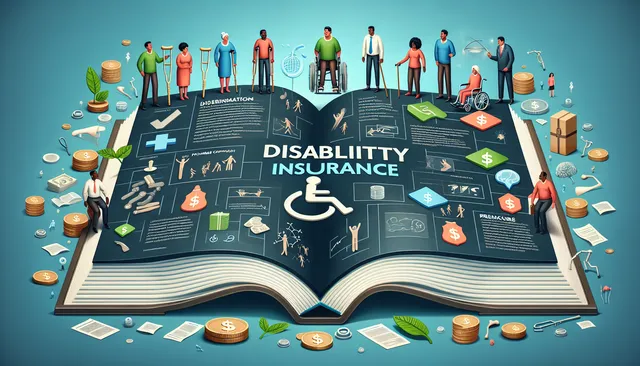
Understanding Disability Insurance: A Comprehensive Guide
Life is unpredictable, and while we take precautions to safeguard our health and well-being, unforeseen circumstances can disrupt even the best-laid plans. Disability insurance exists as a financial safety net for such situations, offering protection when your ability to earn an income is compromised due to illness or injury. In this blog post, we'll take an in-depth look at disability insurance, its importance, types, and how to choose the best policy for your needs.

What is Disability Insurance?
Disability insurance is a type of coverage that replaces a portion of your income if you're unable to work due to illness, injury, or a disability. It ensures you can continue to meet your financial obligations, such as paying for rent or mortgage, utilities, groceries, and other day-to-day expenses, even if you're no longer able to work temporarily or permanently.
While many people associate disability with severe or catastrophic events, the reality is that disabilities can range from chronic illnesses to accidents that lead to temporary impairments. According to the Social Security Administration, more than one in four 20-year-olds today will become disabled before reaching retirement age. This statistic highlights the importance of having a financial backup plan in place.
Why is Disability Insurance Important?
Your ability to earn an income is arguably your greatest financial asset. Without it, maintaining your lifestyle and meeting financial responsibilities can become incredibly challenging. Disability insurance ensures that you won’t have to deplete your savings or take on debt to manage your expenses if you're unable to work.
Here are some key reasons why disability insurance is essential:
- Income Protection: It provides a steady stream of income when you're unable to work, reducing financial stress during recovery.
- Covers Everyday Expenses: From housing costs to utility bills and groceries, disability insurance helps cover your regular expenses so you can focus on getting better.
- Long-Term Planning: For those with dependents, disability insurance ensures that your family’s financial needs are met even if you're unable to contribute due to a disability.
- Supplement to Social Security Benefits: While Social Security Disability Insurance (SSDI) exists, it may not be sufficient or guaranteed, as approval can be both time-consuming and stringent. Private disability insurance offers an additional layer of protection.
Types of Disability Insurance
Disability insurance is generally divided into two main categories: short-term disability insurance and long-term disability insurance. Let’s explore the differences.
Short-term disability insurance provides coverage for a limited period, typically ranging from a few weeks to a few months. It is designed to replace a portion of your income during temporary periods of disability caused by injuries, illnesses, or surgeries.
- Coverage Period: Typically 3 to 6 months, depending on the policy.
- Waiting Period: Usually starts after a short waiting period, such as 7 to 14 days.
- Examples of Covered Conditions: Recovery from surgery, maternity leave, or a temporary illness or injury.
2. Long-Term Disability Insurance (LTD)
Long-term disability insurance is designed to provide income replacement for extended periods, often until you recover or reach retirement age. This type of insurance is critical for serious illnesses or injuries that have long-term consequences.
- Coverage Period: Ranges from a few years to age 65 or even lifetime benefits, depending on your policy.
- Waiting Period: Typically 90 to 180 days.
- Examples of Covered Conditions: Chronic illnesses, severe injuries, or permanent disabilities.
Some employers offer both STD and LTD as part of their benefits package, but these policies may not always provide sufficient coverage. In such cases, purchasing an individual policy can bridge the gap.
Individual vs. Group Disability Insurance
Disability insurance can be obtained through your employer (group policy) or purchased individually. Each option has its pros and cons:
Group Disability Insurance
- Pros:
- Often subsidized or fully paid by the employer, making it more affordable.
- Easier to qualify for, as there’s usually no medical underwriting.
- Cons:
- Coverage may be limited, both in terms of the amount and duration of benefits.
- Tied to your employment, meaning you lose coverage if you leave your job.
Individual Disability Insurance
- Pros:
- Tailored to your specific needs, with customizable coverage options.
- Portable, so you can keep the policy even if you change jobs.
- Cons:
- Typically more expensive than group policies.
- Requires medical underwriting, which may affect eligibility or premiums.
Key Features to Look For in a Disability Insurance Policy
When shopping for a disability insurance policy, it’s essential to consider the following features:
- Definition of Disability: Policies may define disability differently. Some only cover "total disability," while others also cover "partial disability." Look for a policy with a clear and comprehensive definition that aligns with your needs.
- Own Occupation vs. Any Occupation:
- Own Occupation: Covers you if you're unable to perform the duties of your specific job.
- Any Occupation: Covers you only if you're unable to perform any job for which you're reasonably qualified, which is more restrictive.
- Benefit Amount: Policies typically replace 50% to 80% of your income. Make sure the benefit amount is sufficient to cover your essential expenses.
- Waiting Period: This is the time you must wait before benefits begin. Longer waiting periods usually result in lower premiums, but it's important to choose a waiting period you can afford.
- Benefit Period: This is the length of time you'll receive benefits. Longer benefit periods provide more security but may come with higher premiums.
- Non-Cancelable and Guaranteed Renewable: These features ensure that your policy cannot be canceled or the premiums increased as long as you continue paying.
- Riders: Optional add-ons, such as cost-of-living adjustments (COLA) or future purchase options, can enhance your policy's coverage.
How Much Disability Insurance Do You Need?
Determining the right amount of disability insurance depends on several factors, including your income, expenses, and savings. Start by calculating your monthly financial obligations, such as:
- Mortgage or rent payments
- Utilities and groceries
- Health insurance premiums
- Debt payments
- Childcare or education expenses
Next, consider how much of your income would need to be replaced to cover these expenses. Remember to account for other sources of income or savings that could supplement your needs.
The Cost of Disability Insurance
The cost of disability insurance varies based on factors such as:
- Age and Health: Younger, healthier individuals typically pay lower premiums.
- Occupation: Jobs with higher risks of injury may come with higher premiums.
- Coverage Amount and Duration: More comprehensive policies with higher benefit amounts and longer benefit periods cost more.
On average, disability insurance premiums range from 1% to 3% of your annual income. While this may seem like an added expense, the peace of mind it provides is invaluable.
Final Thoughts
Disability insurance is an essential component of a robust financial plan. It protects your income, ensures your financial stability during challenging times, and provides peace of mind for you and your loved ones. Whether you’re choosing a group policy through your employer or purchasing an individual plan, take the time to understand your options and select a policy that aligns with your needs.
Life may be unpredictable, but your financial future doesn’t have to be. By investing in disability insurance, you’re taking a proactive step toward safeguarding your most valuable asset—your ability to earn an income. Don’t wait for the unexpected to happen; start exploring your options today and secure your financial well-being for tomorrow.





